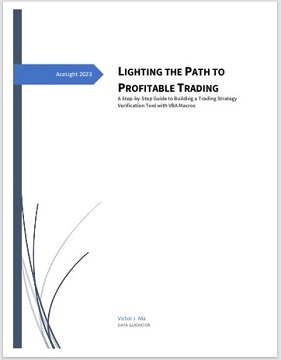Riding the Waves: Mastering Common Stock Trading Strategies
|
|
Picture this: a trader sitting in front of a computer screen, eyes glued to
the charts, heart pounding, and fingers poised to execute the perfect trade.
Suddenly, their cat decides it's the perfect time for a high-speed chase,
zooming across the keyboard, triggering a flurry of unintended trades. Ah,
the joys of trading from home!
Now that we've had a chuckle, let's
get down to business and explore the fascinating realm of common stock
trading strategies. Strap in, because this guide will equip you with the
knowledge and skills to navigate the unpredictable waves of the stock
market.
In the world of stock trading, knowledge and strategy
are essential for success. Understanding common stock trading strategies
empowers traders to make informed decisions, mitigate risks, and maximize
profits.
1. Buy and Hold Strategy
The buy and hold strategy
is a long-term investment approach where traders purchase stocks with the
intention of holding them for an extended period, usually years or even
decades. This strategy relies on the belief that over time, the stock market
tends to appreciate, and quality companies will deliver significant returns.
By focusing on strong fundamentals, such as company financials, market
position, and industry trends, buy and hold investors aim to capitalize on
the long-term growth potential of stocks.
For example, legendary
investor Warren Buffett is well-known for his buy and hold strategy. His
investment in The Coca-Cola Company in 1988, which he still holds today, has
yielded remarkable returns due to the company's consistent growth and
enduring business model. The buy and hold strategy requires patience,
disciplined research, and a thorough understanding of a company's long-term
prospects.
2. Day Trading Strategy
Day trading involves
executing multiple trades within a single trading day. Day traders
capitalize on short-term price fluctuations, aiming to profit from intraday
market movements. This strategy relies heavily on technical analysis, which
involves studying charts, patterns, and indicators to identify short-term
trading opportunities.
For instance, scalping is a popular day
trading technique where traders aim to make small profits from frequent
trades. They exploit brief price changes by entering and exiting positions
swiftly.
It's important to note that day trading requires strict
risk management, as trades are executed within a short time frame. Traders
must be diligent, closely monitoring the market and being prepared to act
swiftly when necessary.
3. Swing Trading Strategy
Swing
trading involves holding stocks for a period ranging from a few days to
several weeks, aiming to profit from short-to-medium-term price
fluctuations. Swing traders use a combination of technical analysis and
fundamental analysis to identify potential entry and exit points.
For
example, swing traders may look for stocks that have recently experienced a
pullback in price within an overall uptrend. They aim to enter at a
favorable price point when the stock is poised for a potential rebound. By
carefully analyzing chart patterns, support and resistance levels, and
technical indicators such as moving averages or relative strength index
(RSI), swing traders seek to capture profits from anticipated price swings.
Swing trading requires patience and discipline, as traders must wait for
the right setup before entering a trade. Stop-loss orders are commonly used
to manage risk, allowing traders to protect their capital if the trade moves
against them.
4. Momentum Trading Strategy
Momentum traders
focus on stocks that are exhibiting strong upward or downward price
movements, accompanied by high trading volumes. The underlying principle is
that stocks showing momentum are more likely to continue their current trend
rather than reverse it.
To identify potential momentum trades,
traders often use technical indicators such as the Moving Average
Convergence Divergence (MACD), Relative Strength Index (RSI), or Bollinger
Bands. These indicators help traders gauge the strength and sustainability
of a stock's price movement.
For example, if a stock has been
consistently trending upward, with increasing trading volume and positive
news catalysts, a momentum trader may enter a long position to capitalize on
the upward momentum. Conversely, if a stock is experiencing a sharp decline
with high volume and negative news, a momentum trader may consider a short
position to profit from the downward momentum.
Momentum trading
requires careful monitoring of stock price movements, as well as prompt
decision-making and risk management. Traders should be prepared to exit
positions if the momentum weakens or reverses.
5. Value Investing
Strategy
Value investing is a strategy that focuses on identifying
undervalued stocks with the potential for long-term appreciation. Value
investors believe that the market occasionally misprices stocks, presenting
opportunities to buy stocks at a discount to their intrinsic value.
Value investors look for stocks that trade at a lower price relative to
their fundamental metrics, such as price-to-earnings (P/E) ratio,
price-to-book (P/B) ratio, or dividend yield. By conducting thorough
fundamental analysis, including examining a company's financial statements,
competitive position, and industry outlook, value investors aim to identify
stocks that have strong potential for future growth.
For instance,
value investors may seek out companies with solid balance sheets, consistent
cash flows, and stable dividends, but are temporarily undervalued due to
market sentiment or short-term issues. By patiently investing in these
undervalued stocks, value investors anticipate that the market will
eventually recognize the true value, leading to price appreciation.
Renowned investor Benjamin Graham, considered the father of value investing,
famously applied this strategy and achieved exceptional returns over his
career.
6. Growth Investing Strategy
Growth investing is a
strategy that focuses on identifying stocks of companies with significant
growth potential. Growth investors seek out companies that are expected to
experience above-average revenue and earnings growth rates compared to the
broader market.
To identify potential growth stocks, investors
typically look for companies with innovative products or services, expanding
market share, and strong industry tailwinds. They analyze financial metrics
such as revenue growth, earnings per share (EPS) growth, and return on
equity (ROE) to assess a company's growth prospects.
For example,
growth investors may target technology companies operating in emerging
sectors like artificial intelligence, cloud computing, or electric vehicles.
These companies often have high growth rates due to market demand and
disruptive innovations.
Growth investors understand that these stocks
may trade at higher valuations, such as higher P/E ratios, as investors are
willing to pay a premium for the growth potential. However, successful
growth investing requires careful analysis of company fundamentals, industry
trends, and risk management to ensure the stocks selected have sustainable
growth prospects.
 We've now explored a variety of ideas related to
common stock trading strategies. Please note, the
most important part is the TEST. Without proper testing processes, including
back-testing and forward-testing, even the most famous trading strategies
may not be suitable for all investors. A trading strategy that works well
for one investor may turn out to be a disaster for another. Therefore,
investors need to do their homework before investing their money. We've now explored a variety of ideas related to
common stock trading strategies. Please note, the
most important part is the TEST. Without proper testing processes, including
back-testing and forward-testing, even the most famous trading strategies
may not be suitable for all investors. A trading strategy that works well
for one investor may turn out to be a disaster for another. Therefore,
investors need to do their homework before investing their money.
The
testing process involves analyzing historical data to evaluate the
effectiveness of a trading strategy. Back-testing involves analyzing past
data to identify whether a trading strategy would have been profitable.
Forward-testing involves applying the trading strategy to current market
conditions to evaluate its effectiveness.
For more details, click
LIGHTING THE PATH TO PROFITABLE TRADING: A Step-by-Step Guide to Building a Trading Strategy Verification Tool with VBA Macros to get the whole tutorial handbook for free!
And click Free Trial to download strategies testing tools, all for a 30-day Free Trial.
Click on Subscription to order more strategies testing tools to help your stock trading.
And there you have it, fellow traders! We've journeyed through the
exciting landscape of common stock trading strategies, from buy and hold to
day trading, swing trading to momentum trading, value investing to growth
investing. Remember, in the unpredictable world of stocks, a good sense of
humor can be a trader's secret weapon.
So, the next time you find
yourself in a nail-biting situation, just take a deep breath, have a laugh,
and remember that even the most seasoned traders have experienced their fair
share of cat-induced keyboard calamities. Embrace the knowledge gained from
this guide, stay disciplined, and may your trades be as successful as they
are entertaining. Happy trading, and may the market be forever in your
favor!
|


|

Free Tutorial
Share
|
|
|
|